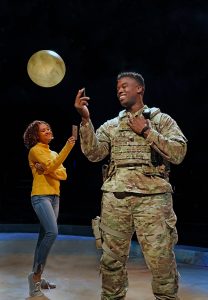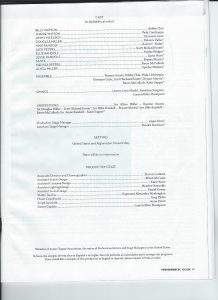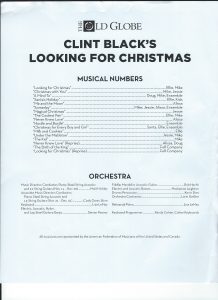Clint Black’s Country Songs Vary the Seasonal Flavor at the Globe But Dark Questions Still Nag
The need for a commercially viable holiday show is an understandable obsession in all segments of the theatre. Festive income can pay bills all year and everybody knows A Christmas Carol by heart these days. So the search continues on stages and screens across the land.
The Old Globe has a proven property Grinching away on its main stage but next door, there are the 250 seats around the arena stage of the White Theatre which Globe boss Barry Edelstein calls a “toxic vortex to be avoided at all costs.”
Thus, Clint Black’s Looking for Christmas, now in a debut run at the White through New Year’s Eve.
That awkward apostrophe in the ponderous title may designate Black’s ownership of the material or may be a contraction reporting that Black is actively searching for the holiday. Either way, it applies. This a show built around songs written and performed over the decades by Black, a prominent country-western entertainer.
It’s actually a pretty good idea, going to the country music well for Christmas material. The melodies tend to be simple, direct ballads and dance tunes hung on powerful, orderly harmonies comfortable for casual ears. The words and the tells stories that suit such sentimental themes as family, home and holiday celebrations.

Aaron C. Finley, Kaylin Hedges and Liana Hunt in the Old Globe’s Clint Black’s Looking for Christmas. Ken Howard Photo.
The sly folk wisdom often slipped into the music among the forlorn love-calls and the rejoicing parties can be put aside for the moment in favor of respect for traditional values built into Christmas. That the family at the center of Clint Black’s Looking for Christmas will be healed by the Christian values of the holiday is virtually certain from the very beginning. The soldier just back from deployment will eventually wrestle his ghosts into memory and rejoin the community. His adorable daughter will have her faith renewed. Even the bereaved will find acceptance.
What will not be solved lies a layer down from this story. What were this soldier and his comrades doing in this peril? They were there by choice, presumably understanding the risks. But why were they put there? Why is their country – our country – keeping them there into, very soon, a third decade? What is the goal? How will we know when it’s reached? There are no battles to diagram, just a persistent attrition. It’s not even clear if anybody really wants us there.
The play has some few words to say on the subject but only generalized homilies. All of the people over there and back home are sweetly noble. “I had forgotten how quiet it is here,” says the vet in wonder. But all the noise and chaos still persist back there where the soldiers who took over from him cringe in fear behind their defensive perimeters, hoping that they’ll make it safely home next Christmas.
If one can bundle this darkness into a corner, Black’s show is a simple holiday sugarplum. The songs tend to be clever in a folksy fashion: “If my ducks are crooked/ My goose is cook-ed…” or “That’s how far a kiss’ll go/Underneath the mistletoe.” And the chord progressions needn’t be written out for experienced players like Matt Hinkley and his versatile band.
Black also collaborated on the book, with James D. Sasser, and there’s little to nitpick there. Well, OK, some of the timeline raises questions. Like our soldier met his wife at a party hosted by his best friend, another soldier in his platoon. His daughter is said to be 9-years-old but he’s still only a staff sergeant and the friend is even lesser in rank. Army promotions surely move faster than that, especially in combat zones. But this moves toward that dark cloud and that’s not why we’re here.
We get what we want when Kaylin Hedges and her four fellow moppets are selling away on songs about Santa Claus, or when Syndee Winters and Liana Hunt, especially well cast as wives waiting back home, pour out their longings.
One of the show’s most effective moments comes when Aaron C. Finley as the soldier and DeLeon Dallas as his best bud join the others in their patrol for “A Mind To,” a yearning for home with plentiful poignance. The least effective periods tend to cluster around any scene including the costumed Santa Claus who, though played well enough by Bryant Martin, comes across as a bit grotesque, especially as the deliverer of the show’s central message of comfort.
Kent Nicholson navigates the quirks of the arena staging with off-handed competence and meshes with Wendy Seyb’s stompy choreography to provide a seasonal musical-comedy glow to the ensemble numbers.
Sean Fanning’s scenery, the subtle costuming of Charlotte Devaux and especially the facile lighting of Rui Rita help the show glide along nicely with only minimal detractions over there in that dark corner.
(Continues in the Old Globe Sheryl and Harvey White Theatre at 7 p.m. Tuesdays, Wednesdays and Sundays; at 8 p.m. Thursdays-Saturdays; and at 2 p.m. Saturdays and Sundays through Dec. 31, 2018.)

Welton Jones has been following entertainment and the arts around for years, writing about them. Thirty-five of those years were spent at the UNION-TRIBUNE, the last decade was with SANDIEGO.COM.






